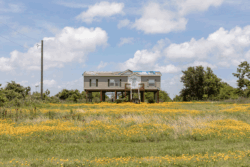Making Room
Advocates for coastal culture plan for Louisiana’s coming population shifts
Published: December 1, 2024
Last Updated: February 28, 2025
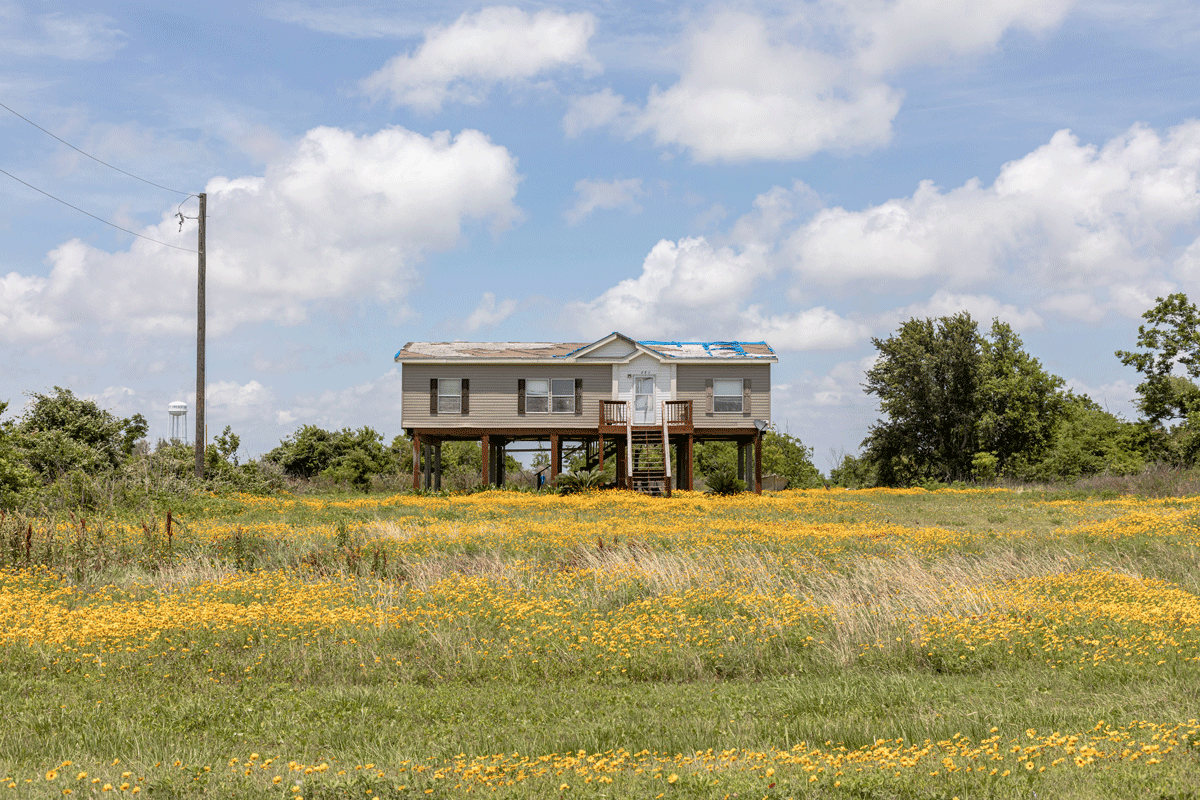
Photo by Matthew D. White
An uninhabited residence on Trosclair Road in Cameron Parish.
In 2005, a few weeks into junior year, eighty new students enrolled at my high school, a splash in our campus community of less than five hundred. But by the end of September, they were gone and so was I. Hurricane Rita tore into my hometown, Lake Charles, and stripped us of status as a safe haven. When our school reopened a month later, maybe one kid remained from our initial Katrina influx.
A million and half people were displaced across the Gulf Coast in the aftermath of Hurricane Katrina, America’s largest internal displacement since the Dust Bowl of the 1930s, according to the National Academies of Science, Engineering, and Math. New Orleans had only half its previous population back by the next summer. Still today, the city contains fewer than 370,000 residents, about three-fourths of the population estimated in the 2000 census.
A 2015 Bloomberg article detailed the city’s changing demography and the complications of bringing displaced New Orleanians back home. Factors included slow redevelopment, limited and pricier housing stock, and the length of time it took simply to figure out where people had gone and why, as the city and federal governments had no comprehensive data source for the displacement that occurred immediately after the storm.
Some arrivals were undeniable. Immediately after Katrina, 250,000 had landed in Houston, with 150,000 still in residence a year later. “According to a 2006 survey by the city of Houston,” states Bloomberg, “about a quarter of former New Orleans residents who were displaced to Houston (including those displaced by Rita, which hit the Gulf less than a month after Katrina) were staked out ‘in FEMA-funded apartments in high-crime, high-poverty neighborhoods on the city’s southwest side.’”
Nearly twenty years later, Louisiana continues to experience major disasters and population shifts. But today, disaster response is focused on both mitigation—lessening the impacts—and adaptation—understanding that if projections of flood risk and sea-level rise in 2050 are even close to true, we need to build differently and think differently before the weather strikes.
Federal funds, including allocations through FEMA’s Building Resilience in Communities and Flood Mitigation Assistance programs, don’t have to be spent on the coast alone. Louisiana is also grappling with the inevitability of increased migration and a depopulating state. At state and local levels, planners are beginning to tackle the critical questions of how South Louisiana residents might—should they decide to migrate—stay within the state and hang on to culture and livelihoods. Where can people go, and how can the receiving communities support their new arrivals?
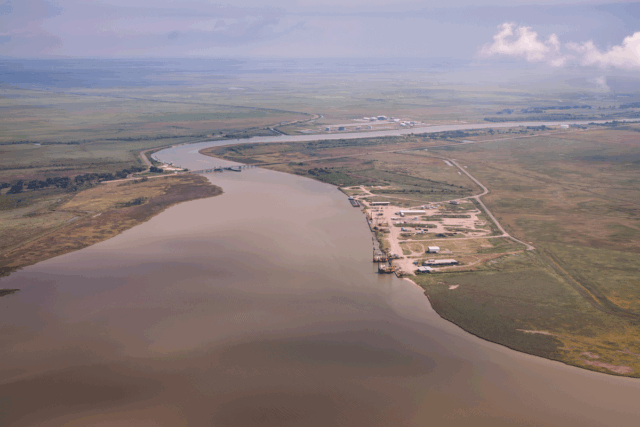
Mermentau River at Grand Chenier in Cameron Parish, Louisiana is a high-risk flood zone. Photo by Matthew D. White
Getting directions
Relocations away from Louisiana’s coast are often precipitated by the episodes FEMA has termed fast-onset disasters, the major weather events that demand a hasty response. A hurricane bends and intensifies toward your home with days or hours to spare, so you hit the road and head for the nearest place out of the bleak red parts of the weather radar or the relative with enough couch and carpet space to temporarily take your brood.
With slow-onset disasters, including sea-level rise and drought, a move out of an increasingly unsafe place can be taken with more deliberation. The receiving communities—the towns and cities at the other end of the equation—can also benefit from knowing that guests, some of whom will become new residents, are on the way.
A new strategy, funded by the Coastal Protection and Restoration Authority, seeks to provide guidance as to which communities are best positioned to house new residents and to direct investment there to make further improvements. “There’s not a lack of information,” said Haley Blakeman, a landscape architect, certified planner, and associate director of the Robert Reich School of Landscape Architecture at Louisiana State University. “There’s too much information. It can be overwhelming as a professional to dig through it. But I wanted to give people information that would help them make decisions [for relocation] when the time comes, instead of going with their gut or acting on old information or impressions.”
Before she came to LSU, Blakeman worked for a decade at the nonprofit Center for Planning Excellence, collaborating frequently with Louisiana’s coastal communities and seeing firsthand the incremental migration away from the rising waters. “I knew people were leaping [north] from bayou to bayou. And they go up one or two communities, especially where they have family. But then they’d be at risk again in a few more years. They were trying to leave a situation where they were vulnerable to the environment, but there were also economic and social factors moving people too.
“It’s not always ‘My house flooded four times.’ It’s ‘my kids have moved’ or ‘my employer has moved’ or ‘the grocery store is not here anymore.’ It’s different for everybody. And I could see people making decisions based on where friends and family were, and not necessarily based on which communities could support them.”
In 2022 Blakeman contacted her longtime colleague Greg Grandy, then deputy director and now coastal resources administrator at the Coastal Protection and Restoration Authority. With an updated Coastal Master Plan due in 2023, Blakeman envisioned including a complementary report on the communities that could best serve coastal Louisianans who wanted or needed to leave home. “I said to Greg, ‘Here’s an idea: what if we thought about places people could go based on data, and then we could direct federal funding to those places to fill some gaps?’”
In August 2023, Blakeman published the report Louisiana Receiving Communities: Prioritizing Receiving Communities: Reducing Environmental, Social, and Economic Risk as People Migrate from the Coast. With a team of five student researchers and extensive interviews with planners, geographers, sociologists, public health officials, and specialists in community development and coastal adaptation, Blakeman spent nine months zeroing in on a definition of a resilient community and finding the places in Louisiana closest to achieving this ideal. She and her team first filtered for towns with populations over 1,000, located south of Alexandria. (This, she told me in our interview, was due to funding requirements for a limited geographic scope as well as the understanding that residents from originating communities may want to continue to work on the coast.)

In 2023, Haley Blakeman and Traci Birch’s students helped create this rendering of a floodable orchard as part of their efforts to propose improvements that will improve Jennings’ capacity as a potential receiving community.
Communities could not be in the high-risk zone for future flooding projected for 2050; the goal is to move some of the estimated 1.2 million people out of this territory, not add to their number. The receiving community sites also needed to have room to grow.
The researchers ultimately considered twenty-six communities for economic and social resilience. “In Louisiana, we think about environmental resilience because we can see it,” Blakeman said. “But if someone leaves a flooded town and moves to a place that doesn’t have jobs or mental health services, that’s a problem.”
The community assessments provided in diversitydatakids.org’s Child Opportunity Index were particularly potent to Blakeman; the index sifts through census data that might be daunting to an individual or small-town planning organization, providing a helpful ranking that included many of the factors she and her team had already identified for resilience. “If we’re supporting the kids, we’re supporting everybody else,” said Blakeman.
From there, knowing that not everyone wants to move to a big city, the team established three typologies of community: urban, tandem near metro, and rural renaissance.
But today, disaster response is focused on both mitigation . . . and adaptation.
Communities were then reviewed for quality of life and capacity to serve their citizens, relative to their size and character. Did the community have a cultural identity? Could you access healthcare and social services? Was there good farmland? An evacuation route close by? How was the transportation? Did the community protect its habitats? Was there economic diversity? Could a new resident receive job training? How much did a house cost?
Festival calendars came in handy, to show researchers a sense of social cohesion as well as opportunities for a potential resident to come test the waters. “From a designer’s perspective, having spaces for people to come together and get to know each other and make social connections is incredibly important,” said Blakeman.
The twelve communities at the top of this ranking include three that especially model the typologies: Hammond (“urban”), Addis and Brusly (coupled together and considered “tandem near metro” for proximity to Baton Rouge), and Sunset (“rural renaissance,” found along I-49 between Lafayette and Opelousas). Others on the priority list are Baker, Baton Rouge, Gonzales, Gretna, Lafayette, Lake Charles, Ponchatoula, and Zachary.
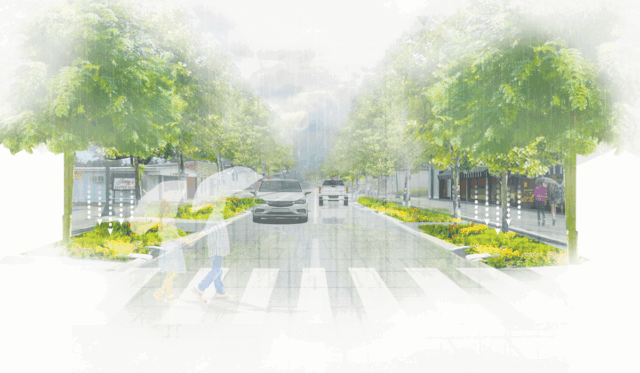
Haley Blakeman and Traci Birch’s students worked with the town of Vinton to create this rendering of stormwater management for the town. Jacob Contreras, Willow Cook, Leah Leblanc, Sydney Milligan, Jerund Sanders, Eric Vanbergen, and Yijing Xiao; via Haley Blakeman
Per the report metrics, the top three communities still have room for improvement. Hammond fell short on metrics regarding affordable housing, number of quality schools, and diversity in the economy. In Addis and Brusly, evaluators felt there were gaps regarding workforce training and pedestrian/bicycle infrastructure, overall population diversity in Brusly, and access to social and healthcare services that don’t require driving across the bridge to Baton Rouge. Sunset did not meet report benchmarks for locally available social services and number of quality schools; its sewerage also needs a retrofit.
Blakeman lists these faults not to slander but to make recommendations for improvements that could be subsidized through federal or state funding, with her report serving as support material for any grant applications. Down the road, she hopes, cities and towns could even apply for Certified Receiving Community status, aspirational for now but comparable to the Certified Retirement Community program that Louisiana established in 2018.
Receiving Communities shares a growing sensitivity for the human element of land loss and coastal planning that can be seen in the 2023 Coastal Master Plan and, from the new position of Chief Resilience Officer, held formerly by Charles Sutcliffe, the 2023 Statewide Resilience Report. It’s encouraging to see the new ways state systems are stepping up to serve its residents as we navigate the burdens of climate impacts. “In this more resilient Louisiana, individuals will not be forced to rely on their ‘resilience’ as they cope with flooded homes or intense heat,” vows the Statewide Resilience Report, “because the systems they rely on when the weather is good will be prepared and functional during times of adversity.”
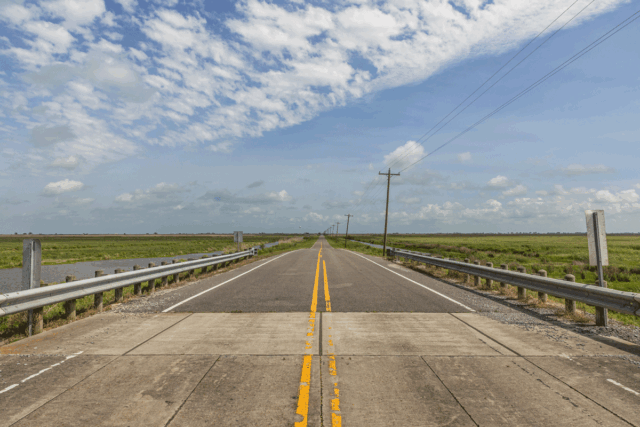
The road in and out of Grand Chenier in Cameron Parish, one of the coastal communities whose residents are increasingly moving to nearby cities like Lake Charles. Photo by Matthew D. White
Culture at risk
The human element of Louisiana has been Maida Owens’s purview since 1988; as director and often sole employee of the Louisiana Folklife Program, within the state’s Department of Culture, Recreation, and Tourism, Owens has a proud track record of documenting the state’s regions, their cultural practices, and their tradition bearers. Funding is not always plush. “The state giveth and the state taketh away,” said Owens. “But there’s always plenty of work to do. No matter the money, there’s so much work to be done.”
Some major accomplishments have included Delta Pieces (2013), a twenty-year project researching and documenting the traditions of twelve northeast parishes; the New Populations Initiative (2012) and its companion The Many Faces of the Bayou State: New Populations in Louisiana, reflecting the state’s immigrant and refugee communities; and the Baton Rouge Folklife Survey (2017), an effort to show how the capital city’s perceived lack of a personality, as compared to neighboring Lafayette and New Orleans, hid a microcosm of Louisiana cultures.
But the 2016 flood of greater Baton Rouge, where Owens has lived most of her life, gave her a new and more anxious perspective on the state’s culture. “When you don’t have power and can’t leave your house, it gets your attention. I started thinking, ‘Maybe I need to evacuate . . . Maybe I need to relocate . . . wait, where is everybody else going?’”
Owens let the idea incubate until 2018, when she and other members of the Louisiana Folklore Society were urged by Jonathan Foret, executive director of the South Louisiana Wetlands Discovery Center, to increase focus on land loss and the cultures at risk as people were leaving.
“Coastal land loss has largely been a science and engineering problem. That’s how it’s been viewed,” Foret told me in a recent interview. “People were being left out of the equation. The cultural value that coastal Louisiana has for the people living here was not being mentioned, or not mentioned in a meaningful way. Why are we saving the land but for the people who live here? It was important to loop in the tradition bearers, folklorists, to make it meaningful for residents.”
Foret’s own family has made the incremental migration up the bayou that Blakeman heard about—from Cocodrie to Bourg, to Chauvin, to Houma. But the strength of Hurricane Ida and the rising insurance costs in its wake have intensified the strain of rebuilding and recovery. “I know people are moving out,” said Foret. “It makes me sad they’re moving out. I don’t want them to leave. I don’t want to leave coastal Louisiana, but I also have a three-year-old son. I want to make sure he has opportunities and that he’s not constantly living in stress. I want him to thrive. That’s not to say he can’t thrive here. But each hurricane season comes, and our anxiety levels go up. We’re all glued to the website or channel or app and waiting for the next one. We all know it’s coming, and that it’s going to happen.”
As a younger man, Foret worked with the Peace Corps and the United Nations and envisioned a career in international development. A trip back home to Houma changed that. “One of the founding members of the Discovery Center came to me and said, ‘Why are you going overseas when we have so many problems to fix here?’ No one had put it to me like that before.”
In his presentations and interviews, Foret uses the idea of “a Trunk of Traditions” to start a conversation about the culture we carry with us as individuals. “In seven generations,” he asks, “what traditions do we hope people have, even if this landscape looks different?”
Why are we saving the land but for the people who live here?
Owens said, “The reason to consider the culture—what I’ve seen scientists respond to in my presentations—is that [people] who are still connected to their culture have a better sense of wellbeing. Wellbeing is related to cohesion. You can adapt to changes.”
“We rely on culture a lot more than we realize when it’s time to get through tough situations,” said Foret. “I’m thinking back to myself with Hurricane Ida, even back to Hurricane Juan in 1985. I remember what was comforting and what wasn’t. Red Cross meals of something not traditional didn’t make me feel as good as a warm plate of jambalaya. It was people coming together, people helping each other that helped me.”
Foret’s pitch to the folklorists has evolved into the broader Bayou Culture Collaborative, an initiative of the Louisiana Folklore Society. Blakeman, Owens, and Foret are all leading voices, and planning, folklife, and climate education are just some of the disciplines represented in the room, which is most often virtual. The group is open to anyone hoping to engage in and advocate for the cultural dimension of response to the changing coast. You could attend a Bayou Culture Gathering, the monthly Zoom meeting on everything from music preservation and community-led adaptation to climate change to fishing practices and collapsing industries. Or you may have a tradition bearer in your community who could be connected to funding to share their craft through a Pass It On Workshop. The Collaborative’s working groups are divided into Culture and Coastal Planning; Artists, Tradition Bearers, and Coastal Issues; Louisiana French Language Preservation; Preparing Receiving Communities; and Protecting Collections. The intent is to build a network of advocates across different fields and to bolster support for Louisiana’s numerous cultures and traditions
The collaborative’s mailing list has topped a thousand, and their opportunities to reach Louisianans, from policy makers and communities to the interested public through presentations and workshops, are growing through their own network as well as funding from state and national organizations (including the Louisiana Endowment for Humanities, which publishes 64 Parishes).
The group is careful in dispensing knowledge without wading into the realm of planned relocation or resettlement for communities. A coordinated move is beneficial for the preservation of a group’s culture, said Blakeman, but she’s insistent that the decision to move is best made by the individual resident or family. Owens agrees. “The Bayou Culture Collaborative does not advocate any one adaptation strategy,” said Owens. “We’re working with people if they want to adapt in place, leave, move to next highest ground, the next state. These are personal decisions, and they should have the autonomy to make decisions.”
The collaborative hopes to keep culture top of mind, though, whether it’s recommending that potential receiving communities create spaces and opportunities for newcomers to share their culture or that a tradition bearer has the funding and local support to share their gifts with the next generation, that the torch is passed.
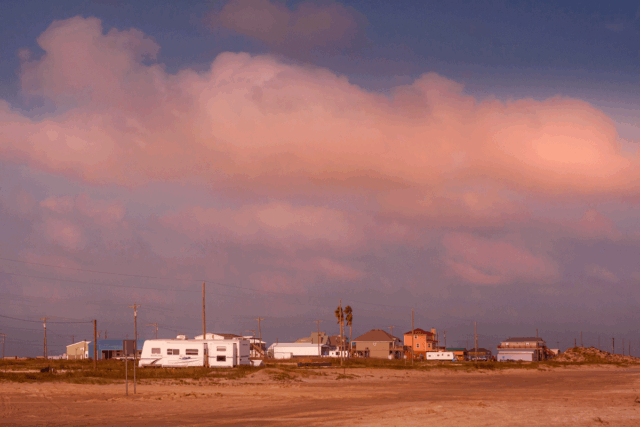
Holly Beach in Cameron Parish. Photo by Matthew D. White
Pass it on—with intention
When I spoke with Foret in July, he was awaiting four loads of crabs for the annual Rougarou Fest, the South Louisiana Wetlands Discovery Center’s Halloween-adjacent event. Community members would be gathering to peel and pick the crabs, to freeze the meat for the festival’s popular seafood gumbo.
“This will be the thirteenth year,” said Foret. “The folklore behind the rougarou [essentially, the Cajun werewolf] is if you put 13 pennies on your windowsill, it protects you. He can’t count past 12. He’s OCD. He gets to 12 and can’t get to 13, so he has to start over again and again, until the sun comes up and he goes back to the swamp.”
Rougarou Fest was created to attract outsiders by showcasing the unique traditions of the bayous of southeast Louisiana, but Foret has seen its target audience evolve. “It’s become a homecoming. People who have moved away from Houma for whatever reason, they’ll use the festival as a time to come back.”
The reunion is bittersweet, with a growing urgency to the celebration. It’s not an easy space to live in, said Foret. “It would just be so much nicer to live in a place of thriving or growth instead of preservation and restoration. There are places of growth in coastal LA, don’t get me wrong. I just wish my little boy would have the same opportunities I had growing up. But those don’t exist anymore. That’s life, I guess.
“I want my son to know he’s Cajun. Even if those traditions don’t exist in the same way they did in the ’80s when I was kid, they can still exist. But that’s the thing: we have to be intentional about it. The days of our culture transferring from one generation to the next just by being alive, that’s kind of over. We now have to transfer culture and traditions very intentionally and with effort, because all things around us that are distracting—cell phones, Netflix, the rest of it—those things are going to win. And it will become more homogenous.”
Foret dwells often on a metaphor he heard from Gary LaFleur, director of the Center for Bayou Studies and Associate Professor of Biology at Nicholls State University. “He said there’s a little minnow in coastal marsh in Louisiana. It’s one of the few species of fish that can tolerate high and low levels of salinity. Saltwater, brackish, fresh water. In those areas with large fluctuations of salinity, it’s one of the few that can live there. But it doesn’t get big because it’s under constant stress. You kind of have to be built for this type of environment. Not everyone can survive in this kind of volatile environment, but we have for a few generations.
“We have such a sense of pride. The Cajun Navy, when they first came out, I could not be more proud to be Cajun. Here’s some citizens with boats going to save people. Yes, that is who we are! That’s what we do! We help each other and we’ll go where we’re needed. There is a sense of pride in recovering. But these hurricanes are coming too hard and too fast.”
Lucie Monk Carter is a writer and photographer in Baton Rouge.
Photos by Matthew D. White. Matthew has been photographing Cameron Parish and the entire Louisiana Coastal Zone for more than twenty years. You can follow his work at matthewdwhite.tumblr.com.
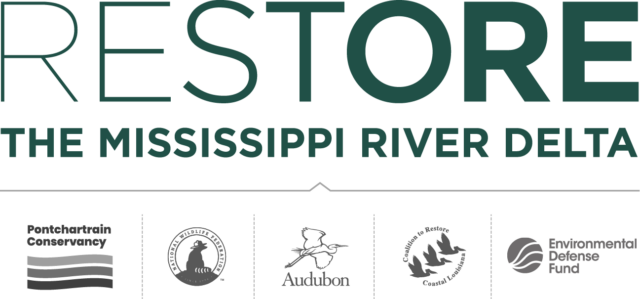 Restore the Mississippi River Delta is a coalition of Environmental Defense Fund, National Audubon Society, the National Wildlife Federation, Coalition to Restore Coastal Louisiana, and Pontchartrain Conservancy. Together, we are working to rebuild coastal Louisiana’s nationally-significant landscape to protect people, wildlife and jobs.
Restore the Mississippi River Delta is a coalition of Environmental Defense Fund, National Audubon Society, the National Wildlife Federation, Coalition to Restore Coastal Louisiana, and Pontchartrain Conservancy. Together, we are working to rebuild coastal Louisiana’s nationally-significant landscape to protect people, wildlife and jobs.
